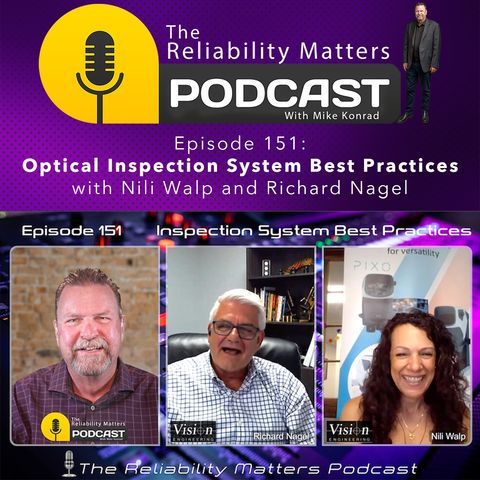Episode 151: Optical Inspection System Best Practices
Sep 10, 2024 ·
59m 29s

Download and listen anywhere
Download your favorite episodes and enjoy them, wherever you are! Sign up or log in now to access offline listening.
Description
Two episodes ago, episode 149, we talked all about automated optical inspection. Today we're exploring the impact of less automated inspection Technology, that being optical microscopes. From commercial, class 1...
show more
Two episodes ago, episode 149, we talked all about automated optical inspection. Today we're exploring the impact of less automated inspection Technology, that being optical microscopes.
From commercial, class 1 electronics to high reliability class 3 electronics, the intricate electronic devices we rely on daily are assembled with astonishing precision. This precision wouldn't be possible without the aid of advanced optical microscopes. These remarkable instruments allow technicians and engineers to inspect, analyze, and ensure the quality of electronic components down to the minutest detail.
In this episode, we'll uncover how optical microscopes have impacted electronic assembly, enhancing productivity, ensuring reliability, and driving innovation.
One of the unique benefits microscopes provide, particularly in hand soldering applications, is the ability to view and solder the assembly under high magnification through the microscope. Obviously, this is not something any AOI system can perform.
But microscopes are not limited to soldering applications. One of the most critical applications of optical microscopes in the electronic assembly industry is the inspection of circuit assemblies for quality assurance. Circuit assemblies are the heart of many products, comprising numerous, highly miniaturized components and connections that must be flawlessly integrated. Even the smallest defect, such as a microscopic crack or an improperly soldered joint, can lead to significant malfunctions or failures.
Optical microscopes enable detailed inspection of these assemblies, allowing quality control professionals to identify and rectify issues that would be invisible to the naked eye.
By providing high-resolution images and magnification, these microscopes help in detecting defects, ensuring correct alignment and polarity of components, and verifying the integrity of solder joints. This meticulous inspection process is crucial for maintaining the reliability and performance of electronic devices, ultimately ensuring customer satisfaction and, in many cases, safety.
We'll hear from two industry experts who will share insights on the latest technological advancements and how these tools are indispensable in maintaining the high standards of modern electronics. Nili Walp is Marketing Manager at Vision Engineering, a manufacturer of microscopes design for various industries, including the Electronics assembly industry, where she has worked for over eight years. Nili earned a bachelors in communications from Boston University.
Richard Nagel is vice president of sales and marketing at vision engineering where he has worked for over 21 years. Richard and Nili will share insights on the latest technological advancements and how these tools are indispensable in maintaining the high standards of modern electronics. Vision Engineering Contact Information: https://www.visioneng.us info@visioneng.us
Vision Engineering Contact Information:
https://www.visioneng.us
info@visioneng.us
show less
From commercial, class 1 electronics to high reliability class 3 electronics, the intricate electronic devices we rely on daily are assembled with astonishing precision. This precision wouldn't be possible without the aid of advanced optical microscopes. These remarkable instruments allow technicians and engineers to inspect, analyze, and ensure the quality of electronic components down to the minutest detail.
In this episode, we'll uncover how optical microscopes have impacted electronic assembly, enhancing productivity, ensuring reliability, and driving innovation.
One of the unique benefits microscopes provide, particularly in hand soldering applications, is the ability to view and solder the assembly under high magnification through the microscope. Obviously, this is not something any AOI system can perform.
But microscopes are not limited to soldering applications. One of the most critical applications of optical microscopes in the electronic assembly industry is the inspection of circuit assemblies for quality assurance. Circuit assemblies are the heart of many products, comprising numerous, highly miniaturized components and connections that must be flawlessly integrated. Even the smallest defect, such as a microscopic crack or an improperly soldered joint, can lead to significant malfunctions or failures.
Optical microscopes enable detailed inspection of these assemblies, allowing quality control professionals to identify and rectify issues that would be invisible to the naked eye.
By providing high-resolution images and magnification, these microscopes help in detecting defects, ensuring correct alignment and polarity of components, and verifying the integrity of solder joints. This meticulous inspection process is crucial for maintaining the reliability and performance of electronic devices, ultimately ensuring customer satisfaction and, in many cases, safety.
We'll hear from two industry experts who will share insights on the latest technological advancements and how these tools are indispensable in maintaining the high standards of modern electronics. Nili Walp is Marketing Manager at Vision Engineering, a manufacturer of microscopes design for various industries, including the Electronics assembly industry, where she has worked for over eight years. Nili earned a bachelors in communications from Boston University.
Richard Nagel is vice president of sales and marketing at vision engineering where he has worked for over 21 years. Richard and Nili will share insights on the latest technological advancements and how these tools are indispensable in maintaining the high standards of modern electronics. Vision Engineering Contact Information: https://www.visioneng.us info@visioneng.us
Vision Engineering Contact Information:
https://www.visioneng.us
info@visioneng.us
Information
| Author | Reliability Matters |
| Organization | Reliability Matters |
| Website | - |
| Tags |
-
|
Copyright 2024 - Spreaker Inc. an iHeartMedia Company
